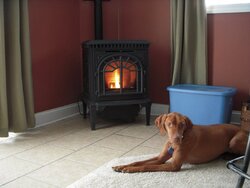Good morning everyone! I'm new to the forums, but I wanted to write it and see if I can get some advice on boosting the performance of my Greenfield corn burning stove. I got the stove about 7 years ago and it has been working well each season. This year I began having a problem with the stove being able to start: I'd push "start" and the stove would shut off after 30 seconds due to inadequate vacuum. If I did manage to get it started (after repeated attempts) I would only be able to achieve a poor burn, ie. the burn pot would overflow even at the slowest auger setting and the clinker would be very light and loose (not the dense clinker that I am used to). I replaced the rope gaskets in both the main door and the ash pan but that did not fix the problem.
I began to search the web and found several forums (including on this site) that said that a clogged stove can lead to this problem. I do all my own maintenance on this stove because I think that my local stove shop is worthless (they don't know much, and they rip me off). My routine maintenance consisted of snaking out the exhaust tube to the outside, vacuuming out the ash traps and blowing out the fan motors with compressed air.
After doing some more reading on the forums, it occured to me that the pathways upstream of the exhaust fan might be clogged. I pulled off the fan and found a bunch of ash caked up just underneath it. I vacuumed that out and also brushed off the fan blades themselves (which were very dirty). I put everything back together again. I did manage to get the stove to pull adequate vacuum, but it still took 2 to 3 attempts at pushing the start button. I'm pretty sure that it should start on the first try. I also was able to run the stove through the night, but the burn pot still fills up pretty fast on the low setting. I think that if I ran it on any other setting, levels 2 through 5, then the feed rate would snuff out the fire; the combustion just wouldn't be able to keep up.
Can anyone recommend anything else? I'd really like to get this thing to be able to run on level 5. I don't think that there is anything mechanically wrong with the stove. Since it's gone 6+ years without a good robust cleaning, then it makes sense that it would be jammed up, but I just don't know where that jam is.
Any suggestions are much appreciated!
I began to search the web and found several forums (including on this site) that said that a clogged stove can lead to this problem. I do all my own maintenance on this stove because I think that my local stove shop is worthless (they don't know much, and they rip me off). My routine maintenance consisted of snaking out the exhaust tube to the outside, vacuuming out the ash traps and blowing out the fan motors with compressed air.
After doing some more reading on the forums, it occured to me that the pathways upstream of the exhaust fan might be clogged. I pulled off the fan and found a bunch of ash caked up just underneath it. I vacuumed that out and also brushed off the fan blades themselves (which were very dirty). I put everything back together again. I did manage to get the stove to pull adequate vacuum, but it still took 2 to 3 attempts at pushing the start button. I'm pretty sure that it should start on the first try. I also was able to run the stove through the night, but the burn pot still fills up pretty fast on the low setting. I think that if I ran it on any other setting, levels 2 through 5, then the feed rate would snuff out the fire; the combustion just wouldn't be able to keep up.
Can anyone recommend anything else? I'd really like to get this thing to be able to run on level 5. I don't think that there is anything mechanically wrong with the stove. Since it's gone 6+ years without a good robust cleaning, then it makes sense that it would be jammed up, but I just don't know where that jam is.
Any suggestions are much appreciated!


 .
.
 Welcome to the forum.
Welcome to the forum.